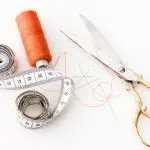Do you know that approximately 65% of fabric frays within a few washes or wears? It's frustrating to put time and effort into a project, only to have the edges unravel.
But fear not! There are simple techniques to prevent raw fabric edges from fraying, allowing you to create professional-looking and long-lasting garments and crafts.
By choosing the right fabric, using pinking shears, applying fray check, overlocking or zigzag stitching, and creating rolled hems, you can keep those edges neat and tidy.
With these methods in your arsenal, you'll never have to worry about fraying ruining your hard work again.
Key Takeaways
- Fabrics with a tight weave, such as cotton, denim, or wool, are less prone to fraying.
- Natural fibers like cotton and wool are less likely to fray than synthetic fibers.
- Using pinking shears is a simple and effective way to prevent fraying and give fabric edges a professional finish.
- Overlocking or zigzag stitching can secure fabric edges and prevent fraying.
Choosing the Right Fabric
When preventing raw fabric edges from fraying, you should choose a fabric that's tightly woven and has minimal stretch. Choosing appropriate materials is crucial in preventing fraying. Fabrics with a tight weave, such as cotton, denim, or wool, are less prone to fraying compared to loosely woven fabrics like chiffon or lace. Additionally, consider the fabric's properties. Natural fibers like cotton and wool are less likely to fray than synthetic fibers.
Understanding fabric properties and fraying is essential. For instance, fabrics with a looser weave or a high degree of stretch are more susceptible to fraying. When selecting a fabric, closely examine its weave and stretch to ensure it meets the criteria for preventing fraying. By choosing the right fabric, you can significantly reduce the likelihood of fraying and ensure the longevity of your project.
It's important to consider the intended use of the fabric. For garments or items that will undergo frequent washing or wear, opt for durable, tightly woven fabrics to minimize fraying. By paying attention to these details, you can effectively prevent raw fabric edges from fraying and create long-lasting, high-quality projects.
Using Pinking Shears
You can use pinking shears to prevent raw fabric edges from fraying by cutting the edges with a zigzag pattern. Pinking shears are a fantastic tool for finishing fabric edges, as they create a zigzag pattern that helps to minimize fraying. Here's how to effectively use pinking shears to prevent fraying:
- Fabric Selection: Ensure that you choose the right fabric for pinking. Pinking shears work best on lightweight to medium-weight fabrics such as cotton, linen, and lightweight wool. Avoid using them on heavy or thick fabrics as they may not produce clean edges.
- Cutting Technique: When using pinking shears, make sure to hold the shears correctly and apply even pressure while cutting. This will help in creating clean and consistent zigzag edges. Take your time and be precise to achieve the best results.
- Alternative Methods: If you don't have pinking shears, there are alternative methods to prevent fraying such as using a serger or overlock machine, applying fray check, or using a zigzag stitch on a sewing machine.
Using pinking shears is a simple yet effective way to prevent fraying and give your fabric edges a professional finish.
Applying Fray Check
An effective way to prevent raw fabric edges from fraying is by applying fray check, which is an excellent solution for securing and reinforcing the edges of your fabric. Fray check is a liquid formula that, when applied to the fabric edges, dries quickly and forms a clear, durable coating that prevents fraying. It is commonly used on fabric hems, seams, and other raw edges to maintain a clean and professional finish. When applying fray check, it's important to ensure that the fabric is completely dry and free from any wrinkles or folds to achieve the best results.
Here's a table to compare different fray check products and their features:
| Fray Check Product | Features | Best For |
|---|---|---|
| Fray Check Original | Dries clear, machine washable, dry cleanable | General use on various fabrics |
| Fray Check Double Strength | Extra durable, dries clear, machine washable | Heavy-duty fabrics and frequent washing |
| Fray Check Wash-Away | Temporary, disappears with washing | Temporary or decorative stitching |
When using fray check, it's essential to test its durability on a small, inconspicuous area of your fabric before full application. This will ensure that the fray check does not cause any discoloration or damage. Additionally, there are alternative products such as fabric glue or clear nail polish that can be used to prevent fraying, but they may not offer the same level of durability and professional finish as fray check.
Overlocking or Zigzag Stitching
To prevent raw fabric edges from fraying, secure them with overlocking or zigzag stitching. These sewing techniques are essential finishing methods that help reinforce the fabric edges and prevent them from unraveling. Here's how to effectively use overlocking or zigzag stitching:
- Proper Seam Allowance: Ensure that you leave an adequate seam allowance to accommodate the overlocking or zigzag stitching. A seam allowance of at least 1/4 inch is recommended to provide enough fabric for the stitches to hold the edges securely.
- Selecting the Stitch: When using a sewing machine, choose the overlock stitch or the zigzag stitch. The overlock stitch encases the raw edge of the fabric, while the zigzag stitch creates a flexible edge that resists fraying.
- Fabric Manipulation: When overlocking or zigzag stitching, gently manipulate the fabric to guide it through the machine. Keep the fabric taut but not stretched to ensure that the stitches are applied evenly along the raw edge.
Creating Rolled Hems
How can you create neatly finished raw fabric edges that resist fraying and add a professional touch to your sewing projects?
Start by mastering the technique of creating rolled hems. Rolled hems are a beautiful and delicate way to finish the edges of lightweight fabrics, providing a clean and polished look.
To achieve this, begin by pressing the fabric edge 1/4 inch towards the wrong side, then press it again to encase the raw edge. Next, stitch close to the folded edge, ensuring the stitches are even.
For sheer or lightweight fabrics, a rolled hem foot attachment on your sewing machine can make this process even easier. This tool helps guide the fabric, creating a narrow and consistent hem.
Rolled hems are perfect for finishing scarves, veils, handkerchiefs, and other delicate items. By mastering this hemming technique, you can elevate the overall quality of your projects and expand your fabric finishing options.
Practicing the art of creating rolled hems will enhance your sewing skills, allowing you to achieve professional results with finesse.
Frequently Asked Questions
Can I Prevent Fraying by Prewashing the Fabric Before Using It?
To preserve fabric, prewashing is an effective method to prevent fraying. Alternatively, using a fray-check solution can also help. Prewashing benefits include removing excess dyes and shrinking, resulting in better fabric preservation and reduced fraying.
What Can I Do if I Don't Have Access to Fray Check or Pinking Shears?
If you don't have fray check or pinking shears, consider using fabric glue or clear nail polish as alternatives for preventing fraying. Another creative solution is to hand-stitch a narrow hem or use decorative stitches to secure the edges.
Are There Any Specific Fabrics That Are More Prone to Fraying Than Others?
Certain fabrics, like loosely woven ones, are more prone to fraying. To prevent this, consider using fabric sealants, serging the edges, or using a zigzag stitch. These techniques can help minimize fraying and extend your fabric's lifespan.
Can I Use a Regular Sewing Machine to Apply an Overlocking or Zigzag Stitch?
Yes, you can use a regular sewing machine for an overlocking or zigzag stitch. Adjust the thread tension, stitch length, and needle size according to your fabric type. Experiment with scrap fabric to find the best settings.
How Do I Prevent Fraying on Delicate or Sheer Fabrics?
To prevent fraying on delicate or sheer fabrics, use fabric sealing techniques like seam sealers or fray check. Alternatively, employ fray prevention methods such as applying a narrow hem, using pinking shears, or serging the edges.
- The Art of the Drape: Discovering Khadi Cotton Jamdani Sarees - June 24, 2025
- The Royal Weave: What Makes a Banarasi Khadi Silk Saree So Special? - June 24, 2025
- A Buyer’s Guide to Handloom Khadi Cotton Sarees - June 24, 2025







